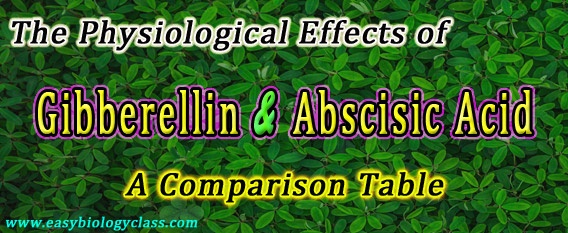Physiological Effects of Abscisic Acid (ABA) and Gibberellic Acid
Physiological Effects of Abscisic Acid and Gibberellic Acid: Gibberellin (Gibberellic Acid) and Abscisic Acid (ABA) are two important plant hormones. Plant Hormones also called ‘Phytohormones’ or ‘Plant Growth Substances’, are signaling molecules produced in very minute quantities in the plants that have immense physiological and metabolic effects. They regulate the growth and development of plants.
The present post discusses the Difference between the Physiological effects of Gibberellin (Gibberellic Acid) and Abscisic Acid (ABA) in plants with a Comparison Table.
Gibberellic Acid: Gibberellic acid or gibberellin, abbreviated as GA, is a major phytohormone produced by some plants and microbes (fungi) which promote the growth and cell elongation. Gibberellic acid was first identified in Japan as a metabolic by-product of a plant pathogenic fungus called Gibberella fujikuroi. The infection of rice plants with this fungi cause a disease called ‘bakane’ meaning ‘foolish seedlings’. The diseased plants will grow much taller than the normal and they eventually die because they are not sturdy enough to support their own weight. The excessive elongation of the internodes in these infected plants was found be to be due to the effect of Gibberellic acid produced by the pathogen.
You may also like NOTES in...
BOTANY BIOCHEMISTRY MOL. BIOLOGY
ZOOLOGY MICROBIOLOGY BIOSTATISTICS
ECOLOGY IMMUNOLOGY BIOTECHNOLOGY
GENETICS EMBRYOLOGY PHYSIOLOGY
EVOLUTION BIOPHYSICS BIOINFORMATICS
Abscisic Acid: Abscisic acid (ABA) is a plant hormone involved in the environment related plant stress responses and seed and bud dormancy. They are so named because their concentration will be more in the newly abscised leaves. Abscisic acid was earlier thought to be involved in the abscission of plant parts, particularly leaves. Now it is clear that the involvement of abscisic acid in leaf abscission is not absolute.

Physiological Effects of Abscisic Acid and Gibberellic Acid
Sl. No. Gibberellic Acid
(GA or Gibberellin)Abscisic Acid
(ABC)
1 Gibberellic Acid (GA) promote plant growth Abscisic acid (ABA) inhibits plant growth.
2 GA removes the dormancy of seeds and bunds. ABA induces dormancy of seeds and buds.
3 GA induces seed germination. ABA inhibits seed germination.
4 GA promote flowering in Long-day plants. ABA promotes flowering in Short-day plants.
5 GA promotes cellular transcription and translation. ABA inhibits cellular transcription and translation.
6 GA prevents leaf abscission. ABA promotes leaf abscission.
7 GA helps in the opening of stomata. ABA promotes the closing of stomata.
8 GA promotes the development of fruits in plants. ABA promotes the abscission of flower and fruits in plants.
9 During the germination of seed, GA promotes the activity of amylase enzyme to hydrolyze the starch to glucose. ABA inhibits the activity of amylase enzyme and inhibits the conversion of starch to glucose and thereby it inhibits the seed germination.
<< Back to Plant Physiology Notes Page
More Lecture Notes from Easy Biology Class…
BotanyZoologyBiochemistryGeneticsCell & Molecular BiologyBiotechnologyPhysiology & EndocrinologyPlant PhysiologyMicrobiologyImmunologyEmbryologyEcologyEvolutionBiophysicsResearch MethodologyBiostatisticsChemistry for BiologistsPhysics for Biologists
Browse more in Easy Biology Class…
Lecture NotesBiology PPTsVideo TutorialsBiology MCQQuestion BankDifference betweenPractical AidsMock Tests (Online)Biology Exams
